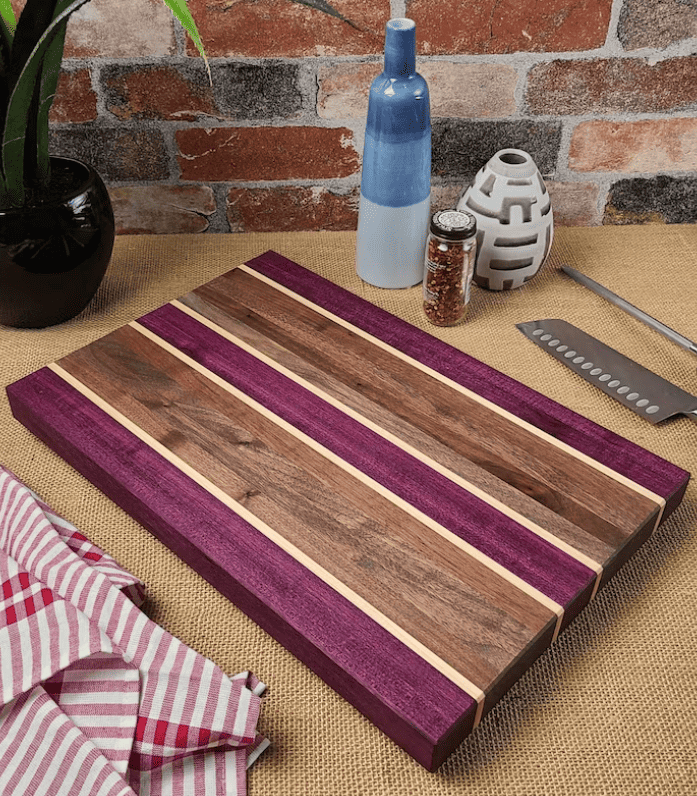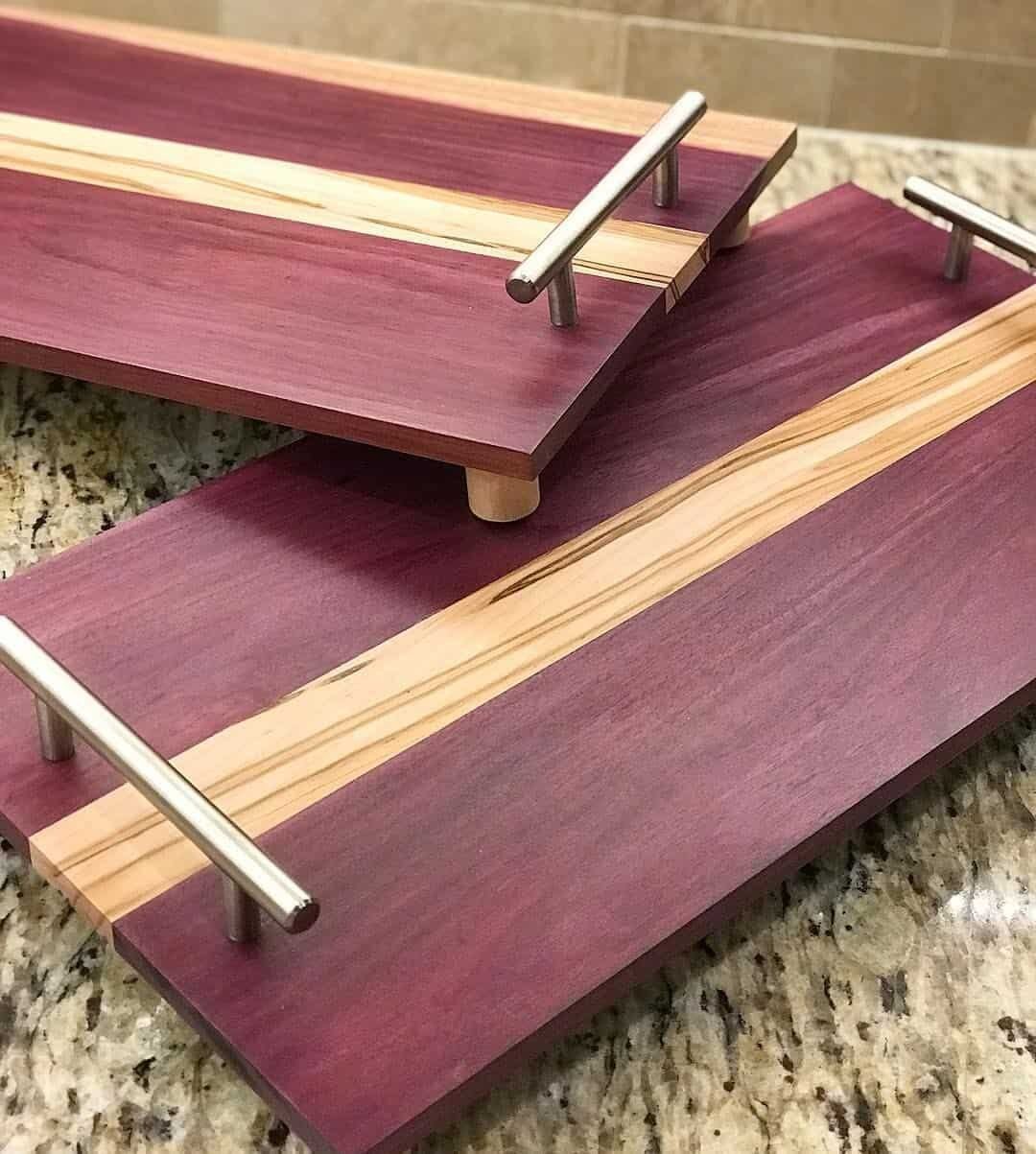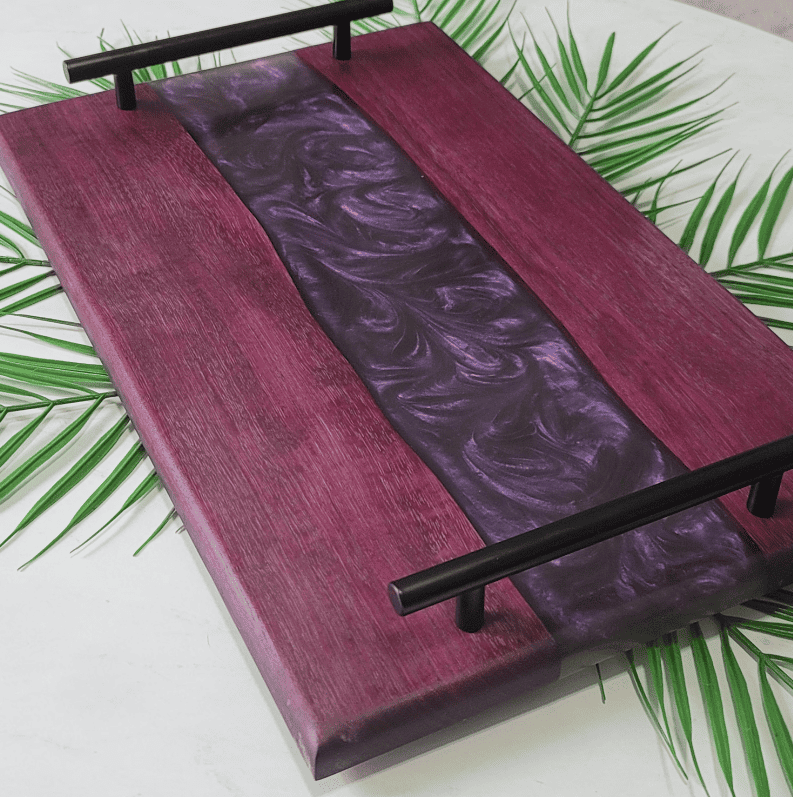If you’re in the market for a new cutting board, you might be wondering if purple heart wood is a good choice. This type of wood is known for its distinctive purple color, which can add a unique touch to your kitchen. But is it safe to use for cutting food?
The good news is that purple heart wood is generally considered safe for cutting boards. In fact, it’s a popular choice among woodworkers because it’s dense, durable, and resistant to bacteria. However, there are a few things you should keep in mind if you decide to use purple heart wood for your cutting board.
Understanding Purple Heart Wood
Purple Heart wood, also known as Peltogyne, is a hardwood species that is native to Central and South America. It is known for its beautiful deep purple color, which can vary in shade depending on the age of the wood and the specific species.
While Purple Heart wood is mainly used for flooring, furniture, and construction, it can also be used for cutting boards. However, there are some things you need to consider before using Purple Heart wood for this purpose.
One of the main concerns with using Purple Heart wood for cutting boards is its hardness. Purple Heart wood is very hard, which can make it difficult to work with and can cause damage to your knives. However, this also means that it is very durable and can last a long time with proper care.
Another concern is the potential toxicity of Purple Heart wood. The dust from Purple Heart wood can cause skin irritation and respiratory problems, so it is important to wear a mask and take other safety precautions when working with it. Additionally, some people may have an allergic reaction to the wood.
If you decide to use Purple Heart wood for a cutting board, it is important to ensure that it is properly finished with a food-safe finish. An unfinished Purple Heart cutting board can absorb water and bacteria, which can be harmful to your health.
Overall, while Purple Heart wood can be used for cutting boards, it is important to consider its hardness and potential toxicity before making a decision. With proper care and safety precautions, a Purple Heart cutting board can be a beautiful and durable addition to your kitchen.
Properties of Purple Heart Wood

Purple Heart Wood is a hardwood that is known for its unique and beautiful purple color. It is a popular choice for furniture, flooring, and decorative items. But can it be used for cutting boards? Let’s take a look at some of the properties of Purple Heart Wood to find out.
Durability
Purple Heart Wood is known for its durability. It is a very hard wood that is resistant to scratches and dents. This makes it a good choice for cutting boards that will be used frequently. However, it is important to note that Purple Heart Wood can be brittle, so it is important to handle it with care.
Hardness
Purple Heart Wood is a very hard wood. It has a Janka hardness rating of 1860, which is higher than most other hardwoods. This means that it is resistant to wear and tear, and can withstand heavy use. However, its hardness also means that it can be difficult to work with, so it is important to use sharp tools when working with Purple Heart Wood.
Water Resistance
Purple Heart Wood is naturally resistant to water. It has a tight grain that helps to prevent water from penetrating the wood. This makes it a good choice for cutting boards that will be used to prepare food. However, it is important to note that Purple Heart Wood can still be damaged by prolonged exposure to water, so it is important to dry it thoroughly after each use.
In summary, Purple Heart Wood is a durable and hard wood that is resistant to scratches, wear and tear, and water. While it can be used for cutting boards, it is important to handle it with care and to dry it thoroughly after each use.
Purple Heart Wood in Kitchenware

If you are looking for a unique and beautiful cutting board, you may have come across purple heart wood. This exotic hardwood is known for its striking purple color and durability, making it a popular choice for kitchenware. Here’s what you need to know about using purple heart wood for cutting boards:
Durability
Purple heart wood is known for its durability and resistance to wear and tear. It is a dense hardwood that can withstand heavy use and is less prone to scratches and dents than softer woods. This makes it an excellent choice for cutting boards, which can take a lot of abuse in the kitchen.
Safety
When it comes to using purple heart wood for cutting boards, safety is a concern. While the wood itself is not toxic, it can cause skin irritation in some people. Additionally, an unfinished purple heart cutting board can absorb water and harbor bacteria, making it unsanitary for food preparation. To ensure the safety of your cutting board, it is important to coat it with a food-safe finish before use.
Maintenance
Like any cutting board, a purple heart wood cutting board requires proper maintenance to ensure its longevity and safety. To clean your cutting board, simply wash it with warm, soapy water and dry it thoroughly after each use. Avoid soaking the board in water or putting it in the dishwasher, as this can cause warping and damage to the wood. Additionally, it is recommended to oil your cutting board periodically to prevent it from drying out and cracking.
In conclusion, purple heart wood can be a beautiful and durable choice for a cutting board. However, it is important to take proper safety precautions and maintenance to ensure its longevity and safety in the kitchen.
Benefits of Purple Heart Wood Cutting Boards

When it comes to choosing a cutting board, there are many options available. However, purple heart wood cutting boards stand out for their unique properties. Here are some benefits of using purple heart wood for cutting boards:
1. Durability
Purple heart wood is known for its hardness and durability. It is one of the hardest woods available, which means it can withstand heavy use without showing signs of wear and tear. This makes it an excellent choice for cutting boards that will be used frequently.
2. Resistance to Water and Stains
Purple heart wood has a natural resistance to water and stains. This means that it won’t absorb liquids or food particles, making it easier to clean and maintain. Additionally, the natural oils in the wood help to prevent bacteria growth, which is important for a cutting board that is used for food preparation.
3. Unique Appearance
One of the most distinctive features of purple heart wood is its deep, rich purple color. This makes it an attractive choice for cutting boards, as it adds a touch of elegance to your kitchen. Over time, the wood will darken to a deep brown color, which only adds to its beauty.
4. Eco-Friendly
Purple heart wood is a sustainable choice for cutting boards. It is harvested from South and Central America, where it is grown in abundance. Additionally, the wood is not treated with any chemicals or preservatives, making it a natural and eco-friendly choice.
In conclusion, purple heart wood cutting boards are a durable, water-resistant, and attractive option for your kitchen. Their unique properties make them stand out from other types of cutting boards, and their eco-friendliness is an added bonus.
Potential Drawbacks of Purple Heart Wood Cutting Boards

While purple heart wood is a beautiful and durable hardwood, there are a few potential drawbacks to using it for cutting boards.
One of the main concerns is the color change that can occur with exposure to light and air. Freshly cut purple heart wood is a vibrant purple color, but this can quickly fade to a dark brown or even ash-gray when used on outdoor decking or garden furniture. If you want to maintain the purple color of your cutting board, you will need to treat it with a UV inhibitor. However, this can potentially affect the food-grade quality of the board.
Another potential issue is the toxicity of the wood. While purple heart wood is not toxic, it can cause skin irritation and respiratory issues in some people due to the dust it produces when cut or sanded. It is important to wear proper protective gear when working with this wood to avoid any negative health effects.
Additionally, purple heart wood is a very hard and dense material, which can make it difficult to work with and maintain. It can be challenging to cut and shape, and it may require more frequent sharpening of your cutting tools.
Finally, purple heart wood is not as readily available as some other types of hardwoods, which can make it more expensive and harder to find.
Overall, while purple heart wood can make a beautiful and durable cutting board, it is important to consider these potential drawbacks before making your final decision.
Caring for Purple Heart Wood Cutting Boards
If you have a cutting board made of purple heart wood, you know it’s a beautiful and durable addition to your kitchen. However, to keep it looking and functioning its best, you need to take proper care of it. Here are some tips for caring for your purple heart wood cutting board:
Cleaning
When it comes to cleaning your purple heart wood cutting board, the key is to avoid using harsh chemicals or abrasive scrubbers that can damage the wood. Instead, use a gentle dish soap and warm water to clean the board after each use. You can also use a mixture of vinegar and water to disinfect the board if needed. Just be sure to rinse the board thoroughly and dry it completely before storing it.
Oil Treatment
To keep your purple heart wood cutting board looking its best, it’s important to oil it regularly. Food-grade mineral oil is a great choice for this task, as it will help to protect the wood from moisture and prevent it from drying out. To oil your cutting board, simply apply a thin layer of oil to the surface of the board and let it soak in overnight. Then, wipe away any excess oil with a clean cloth.
Storage
When you’re not using your purple heart wood cutting board, it’s important to store it properly to prevent it from warping or cracking. Store the board in a dry place away from direct sunlight or heat sources. You can also prop the board up on its side to allow air to circulate around it.
Maintenance
Regular maintenance is key to keeping your purple heart wood cutting board in good condition. Check the board periodically for any signs of wear or damage, such as cracks or splinters. If you notice any issues, sand the affected area lightly with a fine-grit sandpaper and reapply mineral oil as needed.
By following these simple tips, you can keep your purple heart wood cutting board looking beautiful and functioning well for years to come.
Alternatives to Purple Heart Wood for Cutting Boards
If you’re looking for a wood that’s safe for cutting boards but don’t want to use purple heart wood, there are plenty of other options to consider. Here are some alternatives that you might want to consider:
1. Hard Maple
Hard maple is one of the most popular woods for cutting boards, and for good reason. It’s extremely durable, resistant to scratches and dents, and has a tight grain that makes it easy to clean. Plus, it doesn’t absorb moisture as quickly as some other woods, which means it’s less likely to warp or crack over time.
2. Walnut
Walnut is another popular choice for cutting boards, thanks to its rich, dark color and beautiful grain patterns. It’s also a very hard wood, which means it’s resistant to scratches and dents. However, it’s important to note that walnut can be a bit softer than some other hardwoods, which means it may not be as durable in the long run.
3. Cherry
Cherry wood is a great option for cutting boards if you’re looking for a wood with a warm, reddish-brown color. It’s also a very hard wood, which means it’s resistant to scratches and dents. However, like walnut, it can be a bit softer than some other hardwoods, which means it may not be as durable in the long run.
4. Bamboo
Bamboo is a great option for cutting boards if you’re looking for a sustainable, eco-friendly choice. It’s extremely durable, resistant to scratches and dents, and has a tight grain that makes it easy to clean. Plus, it’s naturally antimicrobial, which means it’s less likely to harbor bacteria than some other woods.
5. Teak
Teak is a very hard wood that’s resistant to scratches and dents, making it a great choice for cutting boards. It’s also naturally resistant to moisture, which means it’s less likely to warp or crack over time. However, it can be a bit more expensive than some other woods, so it may not be the best choice if you’re on a tight budget.
Overall, there are plenty of great alternatives to purple heart wood for cutting boards. Whether you’re looking for a wood that’s durable, eco-friendly, or just has a beautiful grain pattern, there’s a wood out there that’s perfect for your needs.
Frequently Asked Questions
Can purple heart wood be safely used for cutting boards?
Yes, purple heart wood can be used for cutting boards, but it is not recommended. The wood is very dense, making it difficult to clean thoroughly, and it can dull knives quickly. Additionally, the dust from the wood can cause nausea and may not be food-grade quality unless treated with a UV inhibitor.
What are the benefits of using purple heart wood for cutting boards?
Purple heart wood is known for its beautiful purple color, making it an attractive option for cutting boards. It is also a durable and long-lasting wood that can withstand heavy use.
How does purple heart wood compare to other woods commonly used for cutting boards?
Compared to other woods commonly used for cutting boards, such as maple and walnut, purple heart wood is much harder and denser. This can make it more difficult to work with and may dull knives more quickly.
What is the best way to finish a purple heart wood cutting board?
The best way to finish a purple heart wood cutting board is to use a food-safe film-building finish, such as mineral oil or beeswax. This will help protect the wood and keep it looking beautiful for years to come.
Are there any special considerations when working with purple heart wood for cutting boards?
When working with purple heart wood for cutting boards, it is important to wear a dust mask to avoid inhaling the dust, which can cause nausea. Additionally, the wood is very hard and dense, so it may be more difficult to work with than other woods.
What are the potential drawbacks of using purple heart wood for cutting boards?
The potential drawbacks of using purple heart wood for cutting boards include the fact that it is very dense and can dull knives quickly. It is also difficult to clean thoroughly and may not be food-grade quality unless treated with a UV inhibitor. Finally, it can be more expensive than other woods commonly used for cutting boards.